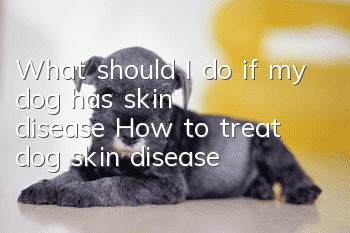What should I do if my dog has skin disease? How to treat dog skin disease!

Dog skin diseases include itching, hair loss, and coat breakage. If you don't pay attention to hygiene or have direct contact with sick dogs, it may be transmitted to humans. So what should you do if your dog has skin disease? How to treat dog skin disease!
Clinical symptoms of canine fungal skin disease:
1. Dog puppies Sporomyces:
It is found all over the world. It is responsible for more than 70% of canine ringworm cases. A variety of animals and people can be infected. The main lesions are small round-like scabs (ringworm) formed on the skin surface. This focal scab skin lesion can appear on any part of the dog, but is most common on the ears, face, neck and tail. This type of lesions, which are mainly skin scabs, are often not accompanied by hair loss. When there are not many lesions, especially when they occur in long-haired dogs, they are often not discovered. Microsporum canis mainly causes tinea capitis in humans.
2. Microsporum gypsum:
It lives in soil all over the world and can cause skin mycosis in dogs and other animals and humans. The onset of this disease is rapid and the damage is severe. The site of occurrence is similar to that of Microsporum. In addition to round pimples, it sometimes causes large-area skin lesions. The coat of the lesion falls off, and dandruff and scabs appear. When secondary bacterial infection occurs, exudative suppuration occurs locally. It can last for months or even years after it becomes chronic.
3. Microsporum audouinii and Trichophyton mentagrophytes:
These two species of bacteria cause rare skin mycosis in dogs. These two molds can also infect people. The former mainly causes tinea capitis in children, and the latter is the main pathogen of athlete's foot in the United States. Dogs usually become infected through contact with sick people.
Popular characteristics of canine fungal skin diseases:
1. Molds have extremely strong vitality and resistance and can parasitize animals and plants or travel with dust. Spread in the air, there are many opportunities for transmission.
2. Skin mold enters the skin through scratches.
3. Infection is mainly through direct contact, but indirect infection can also be caused by contact with contaminated utensils, combs, scissors, mats, etc.
4. Animals and humans and dogs can be infected with each other.
Prevention and treatment measures for canine fungal skin diseases:
1. Some skin mycoses tend to be self-limiting diseases. Although they are not treated, But it can heal on its own.
2. Early-stage sick dogs that are treated in time can be effective only by local treatment with external drugs, but chronic and severe skin mycosis must be treated with oral drugs at the same time.
3. External drug therapy: first wash off the dandruff and scabs, clean the shed and broken coat, and then apply one of the following ointments: clotrimazole ointment, compound salicylic acid ointment, Miconazole ointment or undecyl acid ointment can also be used. Other effective patent medicines, such as tinea chloride, etc., can also be used. 1-2 times a day until completely healed.
4. Oral drug therapy: Flavomycin is the drug of choice, with a daily dosage of 20 to 40 mg per kilogram of body weight. Take once or twice orally for 4-8 weeks. WillMix this medicine with fatty food to promote absorption. It is prohibited for pregnant dogs to avoid causing fetal malformations. Another oral drug is ketoconazole, 10 mg/kg of body weight per day, taken orally three times for 2 to 8 weeks. This medicine is irritating to the stomach, and some dogs may develop allergic reactions such as itching. If the reaction is severe, you should stop taking it and switch to another drug.
5. There are no special preventive measures for skin mycosis. General epidemic prevention work should be carried out mainly. Detect sick dogs early and isolate and treat them promptly. At the same time, pay attention to strengthening nutrition and good management. The feed should contain enough protein, and attention should be paid to supplementing various vitamins, minerals and trace rare elements to enhance the body's resistance. Pay attention to grooming the coat, keeping it clean and preventing scratches.
6. Pay attention to public health and prevent transmission from dogs to humans and humans to dogs. Various skin mycoses in dogs can infect people, especially children who are most susceptible to molds. They often cause tinea capitis and tinea capitis due to contact with sick dogs. Dog families should pay attention to this. At the same time, care should be taken not to infect the owner's ringworm to the dog.
- How does a novice train a Samoyed to use the toilet? Training the Samoyed to use the toilet!
- Causes and treatments for excessive eye mucus in dogs
- How to make the dog listen to the owner when eating, and how to train the dog’s meal order!
- Take stock of the strange cognitions of dogs
- How much does a Tosa dog cost and is it easy to raise? Tosa dog pictures | price | training
- How to train an Alaskan puppy?
- How to bathe a husky in winter? What are the precautions for taking a bath?
- Dog eating grass is an instinctive behavior that is normal
- If you see a puppy urinating in the house, can you spank it?
- How to train a dog to refuse food



